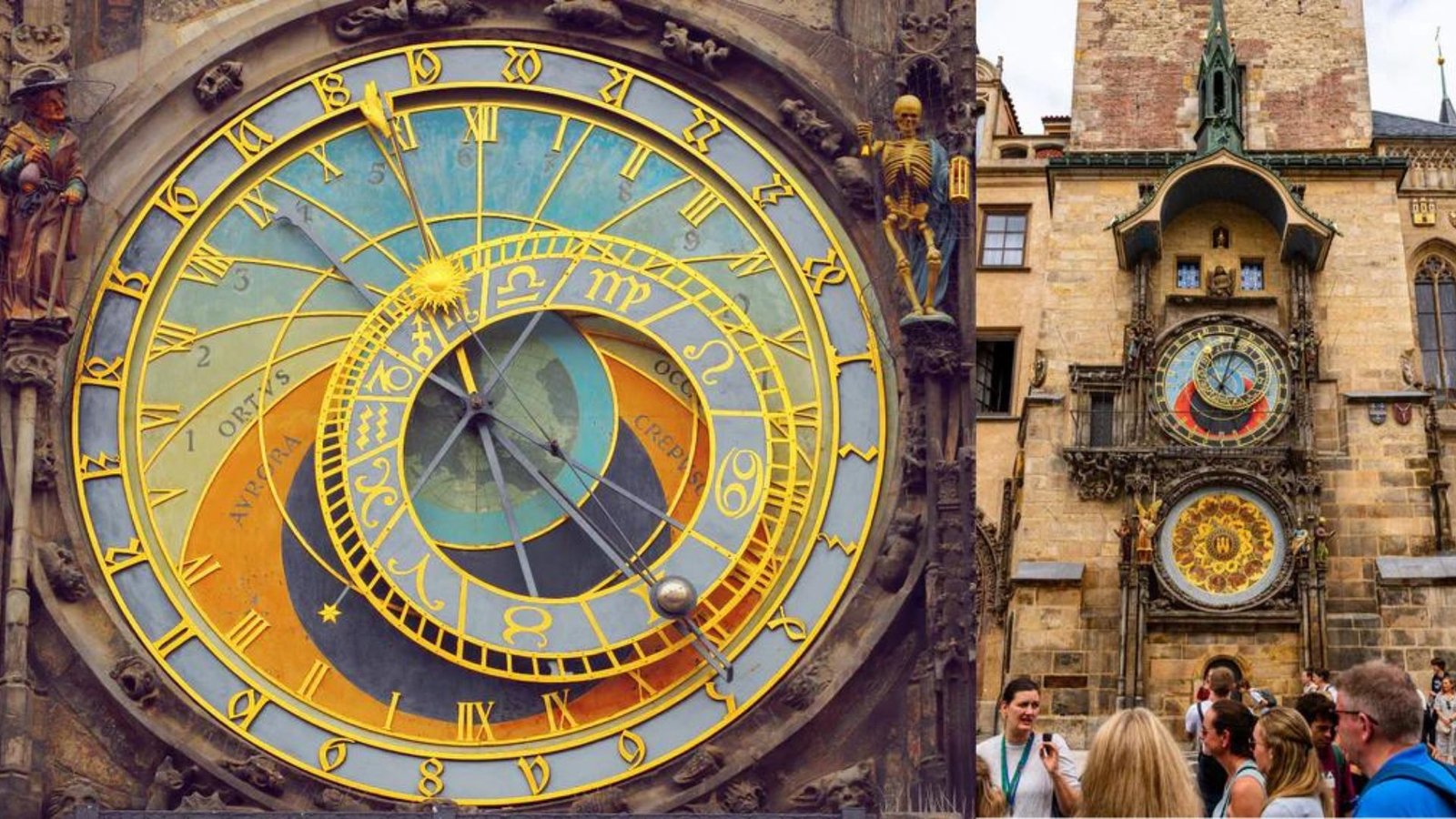Clocks have been an integral part of human history, not just for keeping time but as symbols of culture, craftsmanship, and innovation. Across the globe, there are iconic clocks that have become landmarks, each with its own unique history and significance. Let’s explore the top 10 iconic clocks from around the world.

Big Ben – London, UK
Big Ben, located at the north end of the Palace of Westminster in London, is perhaps the most famous clock in the world. Often, people refer to the entire tower as Big Ben, but the name actually refers to the Great Bell inside the Elizabeth Tower. Its striking design and accuracy have made it a symbol of Britain, and it has been in operation since 1859.
- Fun Fact: Big Ben’s chimes are broadcast on the BBC, making it a beloved auditory symbol of London.
Astronomical Clock – Prague, Czech Republic
Prague’s Astronomical Clock, or Orloj, is a medieval masterpiece located in the Old Town Square. First installed in 1410, it is the third oldest astronomical clock in the world and the oldest still in operation. The clock displays astronomical details such as the position of the sun and moon, zodiac signs, and even the current time.
- Fun Fact: Every hour, a procession of apostles and other figures appear in the clock, drawing large crowds.
Grand Central Terminal Clock – New York, USA
The iconic four-faced brass clock in Grand Central Terminal in New York City is located atop the main information booth in the station’s main concourse. This beautiful clock is a symbol of New York’s bustling energy and timeless elegance. It’s estimated to be worth between $10 and $20 million due to its opal faces.
- Fun Fact: The clock is one of the most popular meeting points for people in New York City.
Kremlin Clock – Moscow, Russia
The Spasskaya Tower of the Moscow Kremlin features a clock that has been ticking since the 15th century. It’s not just a timepiece but a symbol of Russian history. The chimes of this clock are a significant part of Russian New Year’s Eve celebrations, broadcast live across the country.
- Fun Fact: The Kremlin clock has undergone several restorations over the centuries and still remains functional today.
Munich Glockenspiel – Munich, Germany
The Glockenspiel in Munich’s Marienplatz is a part of the New Town Hall. Installed in 1908, it chimes and re-enacts two stories from the 16th century with life-sized figurines that move during the performance, captivating crowds.
- Fun Fact: The Glockenspiel consists of 43 bells and 32 figures that perform twice daily in the summer.
Mount Rundle Clock – Alberta, Canada
Carved into Mount Rundle’s rock face in Banff National Park, the Mount Rundle Clock is a natural sundial that uses the sun’s position to cast shadows across its surface. While not mechanical, it is one of the most unique clocks as it uses natural elements to measure time.
- Fun Fact: The Mount Rundle Clock relies entirely on the sun’s shadow and changes its “time” with the seasons.
Rathaus-Glockenspiel – Graz, Austria
The Rathaus-Glockenspiel clock, located in the town square of Graz, offers a charming display twice daily. It plays music as wooden figures—a couple in traditional Austrian clothing—come out to dance.
- Fun Fact: The Rathaus-Glockenspiel was installed in 1905 and continues to be a popular tourist attraction in Graz.
Zytglogge Clock Tower – Bern, Switzerland
The Zytglogge is one of Bern’s most famous landmarks. This medieval tower, which dates back to the 13th century, features a stunning astronomical clock. Every hour, figures representing characters from Swiss folklore emerge to perform, making it a cultural treasure in Switzerland.
- Fun Fact: Albert Einstein, who lived in Bern, is said to have been inspired by the Zytglogge in developing his theory of relativity.
Mecca Royal Clock Tower – Mecca, Saudi Arabia
The Mecca Royal Clock Tower is part of the Abraj Al-Bait complex in Mecca and holds the title of the largest clock face in the world. The tower is one of the tallest buildings globally and is a beacon for pilgrims visiting the holy city.
- Fun Fact: The clock tower stands over 600 meters high, with a clock face that’s 43 meters in diameter.
Gros Horloge – Rouen, France
The Gros Horloge is an astronomical clock located in Rouen, France. It was built in the 14th century and is one of the oldest working clocks in Europe. It features a single-hand clock, typical of clocks from that period, with beautiful gilded designs on its face.
- Fun Fact: The Gros Horloge’s mechanism hasn’t stopped running for over six centuries.
Conclusion
Clocks around the world serve not only as timekeepers but also as cultural icons. From the grand design of Big Ben to the artistic precision of Prague’s Astronomical Clock, these timepieces remind us of the importance of time and the craftsmanship that goes into preserving it. Each of these clocks offers a glimpse into the culture and history of its location, making them timeless symbols of human achievement.



as I website owner I think the content material here is really good, thanks for your efforts.
Would you be thinking about exchanging hyperlinks?
Wer an Monte-Carlo denkt, der denkt an Glamour, Spaß und an das große Geld.
Schließlich hinterlassen die luxuriöse Atmosphäre und die exquisite Ausstattung
garantiert einen bleibenden Eindruck. Wer jedoch nicht in Monaco zu Hause ist,
sollte sich einen Besuch der Spielhallen vor Ort nicht entgehen lassen.
Die Strecke mit dem gefährlich klingenden Namen führt von La Bollène-Vésubie nach Sospel oder Moulinet.
Besonders ist auch die „Nacht der langen Messer“, eine der berühmtesten Wertungsprüfungen der Welt.
Denn der Asphalt-Wettbewerb, der den Saisonauftakt der Rallye-WM (WRC) markiert, beinhaltet die Nutzung
mehrerer Gebirgspässe. Die Streckenführung und Charakteristik der „Monte“ macht das Bezwingen der
Strecke durch die Teams zu einer echten Herausforderung.
Und ab 2012 ist die Rallye Monte-Carlo auch wieder Bestandteil der Weltmeisterschaft und der Saisonauftakt im Januar.
References:
https://online-spielhallen.de/izzi-casino-bonus-codes-ihr-schlussel-zu-extra-spielguthaben-und-freispielen/
Die große Überzahl der Spielanbieter setzt auf breite Portfolios, wobei die Games
der unterschiedlichsten Hersteller vereint werden. Die Zeit, in der sich deutsche
Online Casinos an einen Provider gebunden haben, gehört
längst der Vergangenheit an. Der Seriositätscheck ist für
dich bei der Wahl vom passenden Spielanbieter somit nur der
erste Punkt.
Die Plattform bietet eine breite Palette an Spielen, darunter Megaways-Slots, Video-Slots und
Frucht-Klassiker. 888Slots ist ein Online-Casino mit
deutscher Lizenz und über 20 Jahren Erfahrung in der Branche.
Das deutsche Handy-Casino LeoVegas führt seit der Gründung im Jahr 2012 den Weg in eine mobile Zukunft.
Das Casino legt großen Wert auf Sicherheit und Fairness und bietet seinen Spielern ein sicheres und verantwortungsvolles Spielerlebnis.
Die Plattform bietet einen deutschsprachigen Kundendienst mit einem ausführlichen FAQ-Bereich, der Spielern bei Fragen und Problemen weiterhilft.
Die Lizenzart sowie die Lizenznummer sollten transparent auf der Webseite des Glücksspielanbieters zur Verfügung gestellt werden. Bei der Suche nach dem besten Glücksspielanbieter
möchte man sich natürlich ausschließlich auf seriöse Online-Casinos konzentrieren.
Die große Vielfalt bietet Slots aller Art, zu denen auch
Frucht-Klassiker, 3D-Slots, Megaways- und Jackpot-Spiele zählen.
References:
https://online-spielhallen.de/exklusive-total-casino-promo-codes-ihr-leitfaden-fur-bessere-boni/